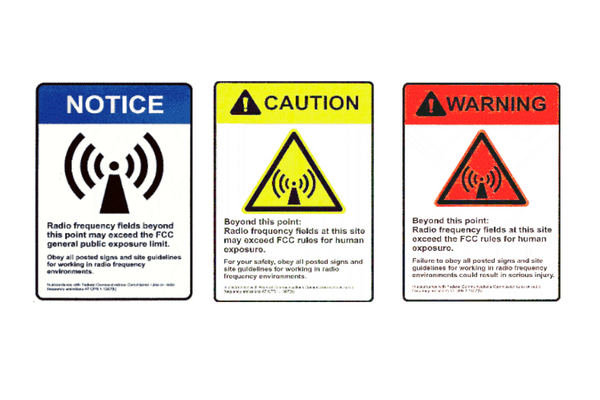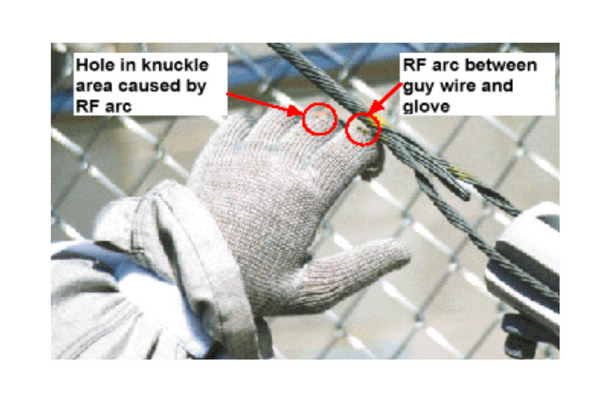 |
Written by Liz McDermott |

We have been exposed to radio frequency (RF) radiation for a while, but not for a significant amount of time to understand its long-term effects. However, we are aware that the direct effects can be quite serious for workers in fields that require them to be close to devices such as cellular towers, power banks, and transmitting antennas with high frequencies. Therefore, caution and awareness are essential when performing tasks in such worksites.
All of us are exposed to radiofrequency electromagnetic (RF-EMF) radiation continually in our everyday lives, from cell phones, wifi, microwaves, and local energy sources. However, those employed in these fields are more likely to experience physical burns from direct contact and a greater concentration of radiation in comparison to the general public.
As a result, it is essential for workers working in RF fields or who are exposed to electromagnetic energy to understand radiation protection best practices. RF-EMF awareness training ensures a safe and secure working environment.
This overview provides information on the potential hazards associated with electromagnetic field exposure, the necessary safety precautions, and the regulations governing RF safety. By investing in this type of training, you make sure employees are informed and protected from any potential risks.
What is Radio Frequency (RF) Technology?
RF energy found in electromagnetic fields and devices is a form of electromagnetic radiation that is used in many different industries. In the context of safety awareness, RF equipment is used in a wide variety of settings, ranging from medical devices to industrial machinery. RF technology is utilized in an extensive range of devices, including industrial sensors and controls, sealers and heaters, medical equipment, mobile phone networks, and wireless networks. It is important to note that human exposure is present in more than just the devices that produce RF energy but also the devices that detect and receive it.
RF is similar to visible light in that it is energy that can be detected, but it does not have any inherent properties that make it dangerous to humans. It is only when there is an increased level of exposure that health risks may occur.

Potential Hazards of Human Exposure to Radiofrequency (RF)
Electromagnetic radiation from RF energy can be harmful to humans when there is an excessive amount of it in the environment. Although the symptoms of exposure vary based on the length and level of human exposure as well as the frequency and power of the RF source, the primary risks include:
- Skin Burns: It is important to avoid prolonged exposure to electromagnetic fields, as they can cause skin burns.
- Eye Damage: RF energy can damage the cornea and the retina of the eye, which can lead to decreased visual acuity or even blindness.
- Cardiac Effects: In some cases, it can lead to heart arrhythmias or even cardiac arrest.
- Cognitive Effects: It has been linked to cognitive impairment and reduced intellectual function.
- Cancer: There is evidence that electromagnetic fields may increase one’s risk of developing certain cancers, particularly cancers of the nervous system.
Necessary RF Safety Precautions
RF safety precautions depend on the level of frequency exposure and the frequency of the source. When possible, it is best to shield the human body from RF energy. In situations where this is not possible, it is essential to ensure that employees are not exposed to excess RF energy by following these basic precautions that will help prevent the transmission of high-intensity signals:
- Limit the amplitude of the signal emitted by the device.
- Limit the frequency of the signal.
- Limit the power of the signal.
- Limit the amount of time an employee is exposed.
- Limit the proximity of the device to the employee.
- Limit the amount of time that the device is exposed to the elements.

Regulations Governing RF Safety Compliance
The primary regulations governing RF safety compliance are the American National Standards Institute (ANSI) C95.1 and the International Commission on Non-Ionizing Radiation (ICNIRP) Guidelines.
The ANSI C95.1 is a standard that was created to ensure that RF equipment is safe for employees in the workplace. It is important to note that this standard does not cover transmission, only exposure in the workplace. Additional standards by the American National Standards Institute include ANSI 1982, which is frequency dependent, and the ANSI/IEEE 1992.
The ICNIRP guidelines are a set of recommendations regarding the level of RF exposure in the workplace. It is important to note that these guidelines only apply to continuous exposure to RF radiation and not to short-term exposure.
While there are no specific OSHA standards for radiofrequency and microwave radiation issues, there are related standards in General Industry (29 CFR 1910) and Construction Industry (29 CFR 1926).
Benefits of Radio Frequency Electromagnetic Safety Training
Radiofrequency safety plays a crucial role in ensuring that workers understand the inherent risks of exposure to non-ionizing and ionizing radiation from electromagnetic fields and have the knowledge, skills, and tools necessary to reduce or eliminate the risk of injury from electrical frequencies and radiation absorption.
Employers looking to use worker downtime for training can use an online course to provide safety guidance and additional information specific to their worksite. Investing in training has numerous benefits for employees and employers, including:
- Employee Safety: Employers who invest in training will have employees who are aware of the risks associated with RF exposure and the necessary precautions to reduce or eliminate risk.
- Improved Productivity: Employers who invest in safety training will have employees who are able to work more efficiently and productively.
- Reduced Liability: Employers who invest in training will be protected from lawsuits and other forms of litigation by reducing potential hazards in the workplace. Online training provides a certificate of completion to make sure employers are protected in the case of an unforeseen audit.
- Reduced Costs: Employers who invest in training will have reduced costs associated with lost production, medical claims, and other expenses.
Conclusion: Invest in RF-EMF Safety Training
Since its inception, radio frequency technology has become a vital part of modern life, but it can be harmful to humans if there is an excessive amount of it in the environment. It is important to understand the basics of radio frequency risks in order to protect employees from any potential hazards of exposure. The best way to achieve this is through RF-EMF safety training.
Consider Vubiz's Working Safely Around Radiofrequency Electromagnetic Fields training course designed for employees who work with or near sources of radiofrequency electromagnetic fields. This training course trains workers on how to work safely with the different types of EMF radiation, and it includes a certificate of completion.
For more information, please contact us to inquire about our Health & Safety training programs.
